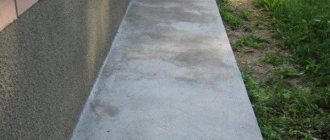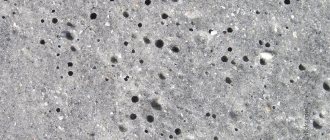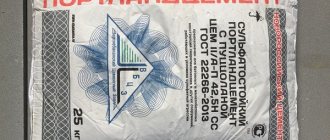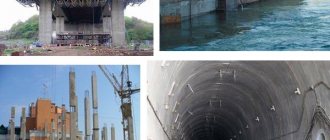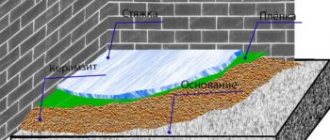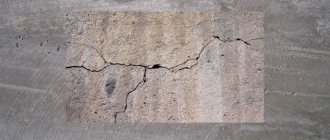Purpose
Nortex is an antiseptic that can disinfect concrete from the appearance of biodegraders. The concrete disinfectant has the following purposes:
- removes mold, fungi and prevents their recurrence;
- performs the function of an antiseptic;
- increases the service life of concrete surfaces;
- has a long-lasting protective effect;
- comes into contact with a large number of paints and varnishes;
- By covering the surface with an antiseptic, a strong protection against leaching is formed.
Return to contents
Effect of impregnation
Nortex penetrates deeply into the thickness of the treated surface, as a result of which the following are completely destroyed:
- mold fungi;
- lichens;
- mosses;
- seaweed;
- seeds and spores.
The antiseptic has a long-lasting effect and helps prevent re-infection. In addition to the disinfectant effect, the product increases the strength of treated materials and increases the service life of buildings and other structures.
Nortex passed state tests, on the basis of which it was recognized as a potent remedy against various types of mushrooms. The pronounced fungistatic properties of the drug are confirmed by the Russian Academy of Sciences. The composition of the impregnation meets all modern sanitary, epidemiological and hygienic standards.
Scope of use
Northex concrete disinfectant is used in the following areas:
- in buildings made of stone, concrete, brick for processing inside and outside the structure;
- antiseptic impregnations are used before gluing wallpaper or covering walls with paints and varnishes;
- the use of bioprotection for the disinfection of building materials is important in places where there is high air humidity and there is no possibility of ventilation;
- for disinfection of materials such as: aerated concrete blocks, slate, cinder blocks, foam blocks, piles, etc.
Return to contents
Application area
Disinfectant Nortex is a universal product intended for treating structures externally and internally. Impregnation provides high-quality protection for buildings made of concrete, stone, and brick. The disinfectant is excellent for preparing walls for wallpapering and coating with paints and varnishes.
The product is used when carrying out disinfection work in a wide variety of types of premises:
- basements;
- saunas;
- greenhouses;
- bathrooms;
- warehouses
Nortex provides reliable bioprotection for various materials in poorly ventilated buildings and in places with high humidity levels. Antiseptic is widely used to disinfect slate, cinder blocks, piles and other areas that are subject to constant exposure to precipitation.
The disinfectant consistently demonstrates a high level of effectiveness. It is advisable to use it both in normal conditions and in harsh industrial environments, in places with harsh climates.
Distinctive features
The disinfectant Nortex differs from similar antiseptics according to the following criteria:
- convenient and easy to use;
- has a low consumption of disinfectant with a high degree of disinfection;
- due to the water base, it does not form traces of soda;
- the possibility of further work with paints and varnishes a day after applying the antiseptic;
- the disinfectant does not pose a threat to animals and humans;
- have a long-lasting effect (depending on operating conditions, it can reach twenty years);
- Nortex antiseptics do not have a pronounced odor, do not affect the skin and are environmentally friendly;
- have high vapor permeability;
- are able to improve the strength characteristics of the material;
- the treated area does not require a specific drying regime;
- the properties of the antiseptic Nortex are confirmed by state tests and sanitary and epidemiological findings.
Return to contents
Instructions for Nortex Disinfector, Instructions for Nortex Disinfector for wood…
The preparation is intended for impregnation of heavily damaged wood and materials based on it, used outdoors and indoors. Nortex-Disinfector is used to destroy mold and wood-staining fungi, wood-boring beetles and prevent their reappearance. Delivered to the consumer in finished form.
Requirements for the surface to be treated with antiseptic Nortex-Disinfector
2.1 The surface to be treated must be dry, cleaned and unpainted. For better absorption, wood moisture content should not exceed 25%.
2.2 When applying the composition, it is recommended to use containers and equipment made of plastic, glass, steel or stainless materials.
2.3 If it is necessary to preserve the decorative appearance of galvanized and copper surfaces, it is necessary to protect them from contact with the composition. In case of contact, rinse immediately (no later than 1 hour) with water. If there is no need to preserve decorative properties, then the composition can be used without restrictions, because There is no destruction of galvanized and copper surfaces.
Surface treatment Nortex-Disinfector for wood
3.1 In order to determine the possibility of processing and evaluate the appearance of the treated surfaces, a small area of surfaces (150x150 mm) should be pre-treated.
3.2 It is recommended to carry out antiseptic work at an ambient temperature of at least 0°C.
3.3 The preparation is applied to wood with a brush or spray method.
3.4 The composition does not tint wood and does not create a film on the surface.
3.5 The consumption of the “Nortex-Disinfector” composition is at least 80 g/m2 (in one layer). Depending on the degree of damage to the surface, the composition is applied in 1-3 layers.
3.6 When applying the composition by spraying, the correction factor for losses should be taken into account (on average 1.15). It is not recommended to maintain high air pressure (the torch should be a jet-droplet) in order to avoid wasteful consumption of biopyrene.
3.7 When processing unplaned surfaces and surfaces with a large amount of mold and wood-staining fungi, it is necessary to take into account the correction factor for the consumption of the drug (up to 1.6), which depends on the degree of roughness and the number of mold fungi.
3.8 After mold fungi are destroyed (after about 7 days), it is recommended to scrape them off, then repeat the treatment.
3.9 After processing, wood and wooden structures do not require special drying; immediately after processing they can be put into production.
Additional features of Nortex-Disinfector
4.1 Treated surfaces can be coated with varnishes, paints, enamels and other compounds after 24 hours. To check the compatibility of the treated surface with paintwork materials, test paint should be carried out on a small area of the surface. If after drying the coating is smooth, without bubbles, pores, wrinkles or peeling, then paint and varnish can be applied to the surface.
Safety and environmental requirements Nortex-Disinfector
5.1 Biopyrene “Nortex-Disinfector” is a low-hazard substance (hazard class 4 according to GOST 12.1.007). The maximum concentration in the air atmosphere is 32.7 mg/m³. Does not have a cumulative effect. It has an irritating effect on the mucous membranes of the eyes, respiratory tract and damaged areas of the skin.
5.2 When processing by spraying, a mandatory safety requirement is the use of personal protective equipment for the respiratory system (Petal-type respirators), eyes and open areas of the body (polyethylene gloves).
5.3 If Nortex-Disinfector gets into the stomach, rinse it with water, then drink ½ cup of a 2% baking soda solution in which 2-3 tablespoons of activated carbon (or 10 tablets) are mixed.
5.4 In case of contact with skin, wash with soap and water; in case of contact with eyes, rinse with plenty of water.
5.5 Biopyren Nortex Disinfector does not burn.
5.6 In case of a spill, wash off with water or collect with any adsorbent substance (sand, sawdust). The generated waste and used containers should be disposed of in the manner established by regulatory legal acts in the field of industrial and consumer waste management.
5.7 Wood after impregnation and drying is safe for people and animals.
6 Transportation and storage Nortex-Disinfector
6.1 Biopyrene “Nortex-Disinfector” is transported by all modes of transport in accordance with the cargo transportation rules in force for this type of transport.
6.2 Transportation by road is carried out in open or closed vehicles in packages in shrink film of 4 (9) bottles with a net weight of 2.6 kg (0.9 kg), formed into pallets stacked in one tier. It is possible to transport individual packages in stacks of no more than two tiers using cushioning material (fibreboard, cardboard). The barrels are loaded in two tiers, lined with chipboard sheets and secured against movement in the horizontal plane.
6.3 Transportation by rail is carried out in containers in accordance with GOST 20435 or GOST 15102. Pallets with bottles must be stacked in rows in one tier. Barrels are loaded into a container in two or three tiers with platforms installed. The voids are filled with cushioning material. The barrels are prevented from moving in the horizontal plane.
6.4 Transportation by river and sea transport is carried out in containers in accordance with GOST 20435, the loading method is similar to loading into railway containers.
6.5 Biopyren “Nortex-Disinfector” is stored in closed PET containers. at ambient temperatures from minus 50°C to plus 50°C. At ambient temperatures below minus 1°C, it partially crystallizes and retains its properties after defrosting. Shelf life: 2 years.
6.6 “Nortex-Disinfector” is recommended to be stored in dry, closed warehouses with natural ventilation and humidity not exceeding 70%; it must be protected from sunlight and other thermal effects.
6.7 The distance between the lamps and the product must be at least 0.5 m.
6.8 In warehouses with a non-rack storage method, materials must be stacked.
6.9 Barrels with the “Nortex-Disinfector” composition must be installed vertically on the floor when manually stacked in no more than 2 tiers, and when mechanizedly laid in no more than 5 tiers. The stack width should be no more than 2 barrels. The width of the main passages for transporting barrels should be at least 1.8 m, and between stacks - at least 1 m.
6.10 In a group package of 4 (9) PET bottles “Nortex-Disinfector” it is allowed to be stacked in 5 tiers, vertically.
Manufacturer's warranty for Nortex-Disinfector
7.1 All declared indicator values are based on test results and are ensured in strict compliance with the instructions for use.
7.2 The consumer is responsible for the correct use of the composition.
7.3 When processing surfaces, the consumer must take into account circumstances that may affect the quality of processing.
7.4 When using the composition without pre-treatment, claims regarding the appearance of the treated surfaces will not be considered.
PASSPORT for Nortex-Disinfector
Name: Biopyren Nortex - DISINFECTOR for wood.
TU 2499-017-24505934-02 (OKP 2499908)
Produced by the copyright holder NPO NORT LLC in Izhevsk, Udmurt Republic
Sanitary and epidemiological conclusion: No. 18.УЦ.02.249.П.000010.01.08
QUALITY INDICATORS Nortex-Disinfector
| The name of indicators | TU 2499-017-24505934-02 standard | Batch number | Actually according to the analysis |
| Appearance | Transparent pink liquid. Opalescence is allowed. During storage, sediment may form that does not affect the quality of the composition. | ||
| Density at 20°C, g/cm3 | 1,010…1,020 | ||
| pH of the environment | 8,5…9,5 |
Use in accordance with the instructions for use
Laboratory conclusion: product quality complies with TU 2499-017-24505934-02.
Main parameters and characteristics of Nortex-Disinfector
| Protective ability against wood staining and mold fungi | Highly effective antiseptic |
| Consumption for wood antiseptic, g/m2 not less | 80 |
| Crystallization temperature, °C | At temperatures below minus 1ºС it partially crystallizes, after defrosting it retains its properties. |
| Temperature during processing, °C | 0...plus 50 |
| Operating temperature, °C | minus 50…plus 110 |
| Efficiency of antiseptic treatment, years: | |
| - when operating in an open atmosphere of a temperate climate for external surfaces that are not subject to washout, with variable humidity and temperature under the influence of solar radiation and wind | 8 |
| - inside heated residential and non-residential premises (summer houses, verandas, attics, warehouses, garages, etc.) with normal humidity | 18 |
| inside unheated residential and non-residential premises (attic, outbuildings, barns, warehouses, attics, garages, utility rooms, rafter systems, etc.) | 18 |
| — inside hidden cavities (wall voids, spaces between walls and sheathing, etc.) | 30 |
| In risk areas* | update as needed |
* Risk areas include unventilated places with high humidity, floors and the lower crowns of bathhouses; places of contact with the soil; surfaces exposed to the direct action of precipitation, water or mechanical friction; places of moisture condensation (dew point).
Sanitary and epidemiological conclusion No. 18.УЦ.02.249.П.000010.01.08 issued on 01/23/2008. Federal State Institution "Center for Hygiene and Epidemiology in the Urals".
kolorlak.ru
Characteristics
Characteristics of antiseptic.
Disinfector Nortex has the following characteristics:
- the external temperature should be from zero degrees to fifty degrees Celsius;
- the duration of drying the surface after applying the disinfectant is 24 hours;
- pH value of the environment – 8.5-9.5;
- density - at a temperature of twenty degrees 1.010-1.020 g/cu. cm.
Return to contents
Appearance
The Nortex disinfectant has a complex, homogeneous system in which the physical properties and chemical composition are the same in all parts and have a transparent, viscous liquid consistency.
Return to contents
Hazard Class
According to the state composition, the Nortex disinfectant is a moderately dangerous product with hazard class 3.
Return to contents
Consumption
Consumption of Nortex antiseptic:
- for preventive purposes, 80 grams per square meter;
- when treating the affected area, 160 grams per square meter.
Return to contents
Duration of preservation of the bioprotective effect
Operating principle.
The duration of the effect of bioprotection is influenced by the operating conditions of the concrete surface:
- Domestic premises where continuous heating is carried out are disinfected once during the entire service life;
- the service life of the external parts of structures without treatment with antiseptic agents is eight years;
- in rooms where there is no heating, concrete surfaces are disinfected after eighteen years;
- in places where there is periodic contact with a contaminated source, the coating is constantly processed when signs of mold or mildew appear.
Return to contents
Storage conditions and shelf life
Antiseptic Nortex should be placed in well-ventilated warehouses, providing the product with protection from sun exposure. The product must be in closed containers, at an ambient temperature from -50°C to +50°C, with a humidity of no more than 70%.
Should be considered! At minus t, the disinfectant undergoes partial crystallization, but after defrosting it acquires its previous properties.
The shelf life of antiseptic impregnation is two years. After this period, the effectiveness of the product decreases, and therefore it should not be used.
Types of antiseptics
At the moment, there are 2 main groups of antiseptics for concrete: against mold and mildew. Usually they begin to resort to their help when infection has already occurred. At the construction stage, it is important to carry out preventive treatment to prevent the rapid spread of pathological microorganisms.
It is best to choose impregnations that penetrate to a depth of 1.5 meters. Such agents can suppress the activity of entire fungal colonies, mold and other pathogenic microorganisms. In modern construction, organic products, such as copper sulfate, sodium fluoride and others, are used least often. They are unsafe and can harm the human body. There are the following types of impregnations for concrete:
- Water soluble. They are water based. Over time, such compounds are washed out of concrete, so it is best to use them indoors. If you decide to use such compounds outdoors, then the walls must be additionally coated with varnish or resin. This antiseptic is most often based on sodium fluoride. It is very dangerous for fungi and any living organisms. To reduce toxicity to humans, this impregnation is mixed with cement or lime. The advantages of water-soluble impregnations include the almost complete absence of odor and low flammability.
- Organic. They are usually used for wood processing. The deeper the impregnation penetrates, the better it will protect against destruction. It is very important to use special protective equipment when working with such chemicals.
- Oily. The main advantages of oily antiseptics include complete non-washing out with water. They are most often used in non-residential rooms or buildings. The impregnations smell unpleasant and leave dark marks on the walls. It is almost impossible to apply paint to the treated surface; the composition itself burns very well.
- Combined. They have a very concentrated composition. They are used for preventive treatment of walls. If treatment is needed, the composition is not diluted.
Review of popular tools
3. Oily – Belinka, Neomid and others have proven themselves to be effective in protecting external structures (roofs, facades, etc.).
There are many compositions of impregnation brands. The most popular are Tiprom, Mipor, Nortex, Belinka, Ceresit, Kapatoks, Teknos Rensa Homepesuliuos, PUFAS Glutoclean. Before making a decision, it is advisable to take into account certain features of choosing a drug.
How to choose a mixture - what to consider:
Specifics of concrete
After complete setting, 4 weeks after mixing cement with water, the concrete slurry turns into a very durable artificial stone. Inside, this material has a porous structure.
These pores easily absorb moisture, which may contain various biomaterials. All this has a very negative impact on the performance characteristics of concrete.
Inside, the concrete consists of small cells
So, the porous structure of artificial cement stone results in 2 rather serious disadvantages of concrete surfaces:
- high hydrophilicity;
- conditionally low density.
To improve concrete performance in these properties and make cement surfaces moisture-proof, impregnation materials are used.
Any concrete surface needs impregnation
Homemade remedies against fungus and mold
Sometimes folk remedies are used against fungus, one of them is vinegar and soda. Before treating infected surfaces, scrape off all the fungus with a spatula and wipe the walls with a rag soaked in vinegar or spray the product onto the walls with a spray bottle.
To obtain a soda solution, simply dilute a teaspoon of soda in a glass of water and apply a homemade antiseptic to the infected walls with a rag or spray. It is important to treat even hard-to-reach surfaces to ensure that fungal colonies are destroyed. If, after treating with soda and vinegar, mold appears again, it is necessary to use special means to combat the fungus.
Review of antiseptics for artificial stone
Treatment of affected surfaces
- Take care of safety: prepare special personal protective equipment, isolate children and animals from the access area.
- Prepare the surface by removing all microorganisms and drying.
- Dilute the drug according to the instructions and in accordance with the task (prevention requires less concentration, removal of the parasite requires more).
- Apply impregnation with a brush, roller or spray. Repeat the procedure one or more times.
- In difficult places exposed to humidity, with poor ventilation, carry out treatment regularly, as usual - add a disinfectant to the finishing materials every time repairs are performed.
Kawabanga! How to choose a putty for concrete
Selection and use of antiseptics
The choice of an antiseptic for concrete must be approached extremely responsibly. How long the strength of a concrete wall will remain depends on its specific characteristics. Try to take into account the following instructions:
- When purchasing impregnation, choose one that is designed specifically for concrete.
- Consider the type of processing. Some compounds will not be able to penetrate too deeply, so there will be little point in such treatment.
- Not all negative reviews indicate poor quality composition. Many builders simply breed them illiterately.
- Consider the density of the wall. The more concrete, the thicker the impregnation layer is required.
- If you already have a mold problem, it will be difficult to get rid of it with soaking alone. In such situations, it is necessary to use concentrated products.
- Remember that such compounds are extremely toxic. It is for this reason that you must use protective equipment.
- Before applying the antiseptic, the wall should be thoroughly treated. To do this, remove old wallpaper, remove plaster, try to remove microbial growths.
- When scraping off mold, be sure to keep it moist. This will help prevent it from spreading.
- Purchase the necessary tools in advance - this will make your work easier.
- Before applying the composition, dry the walls in advance.
- The first antiseptic treatment should be generous. The composition needs to penetrate into the deep layers of concrete.
- Be sure to let the surface dry. Once the antiseptic has completely dried, apply the next layer.
- If you leave bare concrete, you will need to perform maintenance treatments from time to time.
- Walls in apartments should be treated once every 15 years (provided they are covered with plaster), but if there is cladding, you can get by with treatment once every 30 years.




